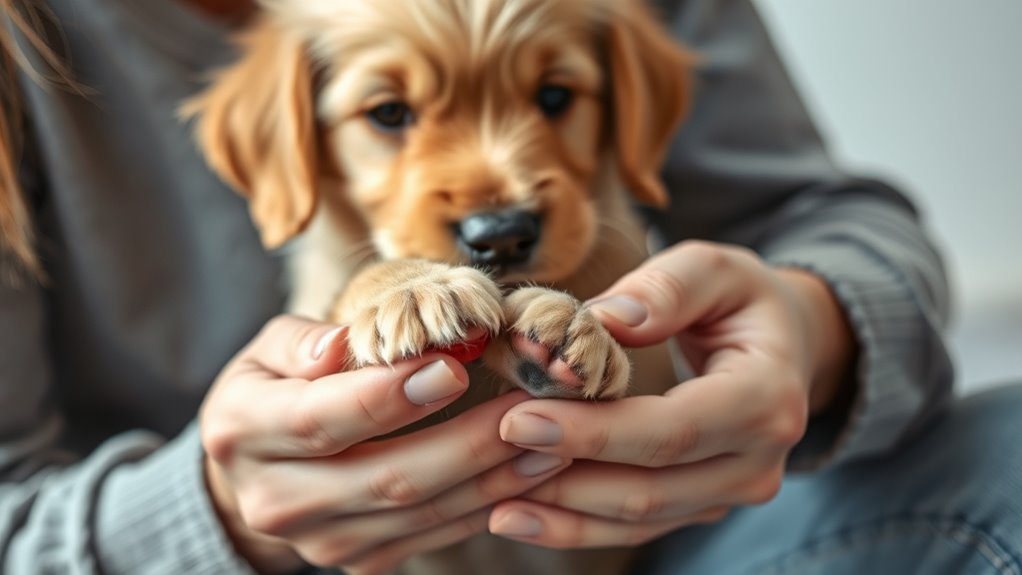To prepare for common injuries, keep a well-stocked pet first aid kit with essentials like gauze, antiseptic wipes, and tweezers. Know how to perform CPR and manage bleeding or wounds calmly and confidently. Keep hazardous items out of your pet’s reach and be aware of toxic foods or plants. Recognizing early signs of distress and having emergency contacts handy can make a vital difference. Continue exploring to master more essential first aid skills for your pet’s safety.
Key Takeaways
- Keep a well-stocked pet first aid kit with essentials like gauze, antiseptic wipes, and tweezers.
- Learn basic CPR techniques for pets, including chest compressions suited for different sizes.
- Store emergency contacts, including your veterinarian and poison control, for quick access.
- Identify common hazards in your home and environment to prevent injuries and poisoning.
- Practice emergency scenarios regularly to build confidence and ensure swift, effective response.

Pet First Aid
Knowing basic pet first aid can make all the difference in an emergency, helping you respond quickly and confidently. When your pet suddenly shows signs of distress, staying calm and knowing the right steps can prevent further injury or even save their life. One essential aspect of pet first aid is understanding CPR techniques. If your pet stops breathing or their heart rate drops, you’ll need to act fast. Begin by checking for responsiveness and breathing. If there’s no response, perform chest compressions tailored to your pet’s size—small dogs and cats require gentle, shallow presses, while larger dogs need firmer, deeper compressions. Never forget to call for emergency help immediately while you start CPR. Practice makes perfect, so familiarizing yourself with these techniques beforehand ensures you’ll be prepared if the worst happens. Understanding the importance of knowing how to perform pet CPR can greatly increase your pet’s chances of survival in an emergency.
Poison prevention is another critical part of pet first aid readiness. Many common household items and foods—like chocolate, xylitol, certain plants, or cleaning supplies—pose a serious threat to pets. To minimize risks, keep hazardous substances out of reach and be vigilant about what your pet has access to. If you suspect your pet has ingested something toxic, contact your veterinarian or a pet poison control center right away. Do not try to induce vomiting unless instructed by a professional, as some substances can cause more damage if vomited. Having the contact numbers saved on your phone or in your emergency kit can save precious time. Prevention is always better than treatment, so regularly check your environment for potential dangers and educate yourself about common poisons.
In addition to CPR techniques and poison prevention, you should also be prepared for minor injuries like cuts, scrapes, or burns. Keep a well-stocked pet first aid kit with sterile gauze, antiseptic wipes, tweezers, and adhesive tape. When injuries occur, clean the wound gently and apply pressure to stop bleeding. Cover the area with sterile gauze and seek veterinary care if the wound appears deep, bleeding persists, or signs of infection develop. Remember, your quick response can reduce pain and prevent complications.
Frequently Asked Questions
How Can I Tell if My Pet Is in Shock?
You’ll notice your pet is in shock if they show signs of dehydration, like dry gums or sunken eyes, and recognize pain cues such as whining or restlessness. They may also have rapid breathing, weakness, or pale gums. Check for cold, clammy skin and a rapid pulse. If you see these signs, act quickly by keeping your pet warm, calm, and seeking emergency vet care immediately.
What Should I Do if My Pet Ingests a Toxic Substance?
Imagine you’re in Alice’s wonderland; suddenly, your pet ingests a poisonous plant or household chemicals. Act swiftly—call your vet or pet poison control immediately. Do not induce vomiting unless directed. Keep the container or label handy to identify the toxin. Remove your pet from the source, monitor their breathing and behavior, and stay calm. Quick action can make all the difference in saving your furry friend’s life.
How to Recognize and Treat a Fractured Bone in My Pet?
You’ll notice fracture signs like swelling, limping, or pain. To treat, gently immobilize the limb and avoid moving it excessively. Use a clean cloth or soft bandage to stabilize the fracture, but don’t try to realign the bone yourself. Keep your pet calm and restrict movement. Seek veterinary help immediately, and remember proper bandaging techniques to prevent further injury or discomfort.
When Should I Take My Pet to the Veterinarian Immediately?
You should head to the vet immediately if you notice emergency signs like severe bleeding, difficulty breathing, or sudden collapse—because ignoring these signs might make you wish you’d called sooner. Veterinary urgency is real when your pet shows signs of pain, seizures, or inability to move. Don’t wait or second-guess; prompt action can save their life. Trust your instincts and seek help when in doubt—your pet’s health depends on it.
How Can I Prevent Common Injuries in Pets?
To prevent common injuries, prioritize pet safety through preventive care. Keep hazardous items out of reach, secure fences, and supervise outdoor activities. Regular veterinary check-ups help identify potential health issues early. Use pet-specific safety gear when needed, and create a safe environment inside your home. By staying proactive and attentive, you diminish risks and ensure your pet remains healthy and injury-free.
Conclusion
By familiarizing yourself with pet first aid basics, you create a gentle safety net for your furry friend. While life can sometimes surprise us with unexpected turns, your calm response and quick actions can help smooth the path ahead. Remember, your caring touch and prepared heart make all the difference. With a little knowledge, you’re not just handling injuries—you’re nurturing hope and comfort, guiding your pet back to better days with confidence and love.










